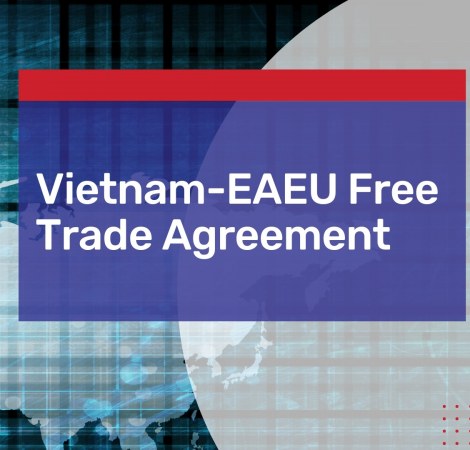Despite the volatility of global trade and the COVID-19 pandemic, revenue from bilateral trade between Vietnam and the Eurasian Economic Union (EAEU) rose to 17.98% in the first ten months of 2020. For the same period in 2019, exports reached 7.18 billion USD, up by 16.15%; imports reached 1.16 billion USD, up by 22.35%.
Several member states of the Eurasian Economic Union including Russia, Belarus, Kazakhstan, Armenia, and Kyrgyzstan ratified the Vietnam – Eurasian Economic Union (EAEU) Free Trade Agreement in Kazakhstan.
Investing in Vietnam? See our A-Z Market Entry Services
Stipulated Agreements in the FTA
Within a 10-year tariff reduction schedule, Vietnam is slated to open its market for almost 90% of tariff lines. Agriculture commodities (such as beef, wheat flour, and dairy products) that were included on the EAEU’s priority list will not have tariffs applied to them. They will be exempted from taxes for a period as shown here:
- three to five years after the EIF(Entry into Force) for processed meat and fish, electrical machinery, agricultural machinery;
- five years after the EIF for pork, chicken;
- and ten years after the EIF for alcoholic drinks and cars.
There is a deadline for tariff elimination for some special products. For instance, petroleum will no longer be subject to tariffs till 2027, and iron and steel will be exempt from tariffs for 10 years.
A total of 90% of tariff lines shall also be eliminated by the EAEU, out of which 59% shall were eliminated immediately upon ratification. Among the product groups that will be exempt from import tariffs are
- Agricultural-forestry-fishery products of Vietnam
- Fishery products
- Certain kinds of fresh and processed vegetables and fruit
- Processed meat and fish,
- Cereals and rice (with a tariff quota of 10,000 tons);
- Industrial products
- Quotas apply to textiles, raw textiles, and footwear (especially athletic shoes)
- Electronic equipment
- Machinery
- Specific pharmaceutical products
- Iron and steel
Source: WTO Center
Growth of Vietnam-EAEU Trade Relations
With an average increase of 30% per year, the trade turnover between Vietnam and the EAEU (FTA VN – EAEU) has shown tremendous growth since the FTA went into effect in 2016. The Agreement creates a vital legal framework that promotes trade and investment between businesses on both sides.
On the Vietnamese side, sectors like textiles, footwear, aquatic products, agricultural products, phones, and components have all taken advantage of incentives under the Agreement, according to data provided by the General Department of Vietnam Customs.
RELATED READING: Vietnam’s Shipping Industry & Port Development Plan for Rising Demand – Trade Surplus of $3.9B
On the EAEU side, the main beneficiaries are freshwater salmon, maize, fertilizers, vegetable oil, iron, steel, trucks, and some diesel-powered transport vehicles. As a result of the Agreement, many Vietnamese and EAEU products are subject to special preferential import taxes.
Total Trade Between the Bloc and Vietnam
| Year | Trade | Growth from the previous year |
| 2016 | USD 3.04 billion | 23% |
| 2017 | USD 3.9 billion | 28.3% |
According to the Vietnamese Communist Review Magazine the two-way trade turnover between Vietnam and the EAEU reached 10.4 billion USD in 2019, an increase of 20.78% compared to 2018. Vietnam’s exports grew by 6.43%, reaching 7.2 billion USD.
With Vietnam only accounting for 0.5% of the EAEU’s imports in the first ten months of 2020, about 1.4 trillion USD, the country has plenty of opportunities to increase its export share in the Eurasian region.
Future predictions and prospects
EAEU countries and Vietnam have taken several measures to boost business under the framework of the Vietnam-EAEU free trade agreement. As a result of this agreement, tariff barriers have been eased of late and bilateral trade turnover has spiked.
The EAEU and Vietnam maintain their efforts to remove trade barriers, implement roadmaps in accordance with commitments, as well as adjust policies. There must be an increase in production and exports of goods in both EAEU countries and Vietnam with comparative advantages in order for the agreement to be effective.
In addition to affecting competition, Vietnam complements EAEU countries in order to boost trade. Several products must be produced by Vietnam that have comparative advantages, including textiles, apparel, footwear, bags, fish, wooden furniture, agricultural products, and other items that the market can’t afford.
Conclusion
With the Vietnam-EAEU Free Trade Agreement in place, both counterparts have laid down a seamless framework for businesses to expand in the coming years. As a result of the new and extensive free trade agreement, Vietnam and the EAEU now share a strong economic bond.
